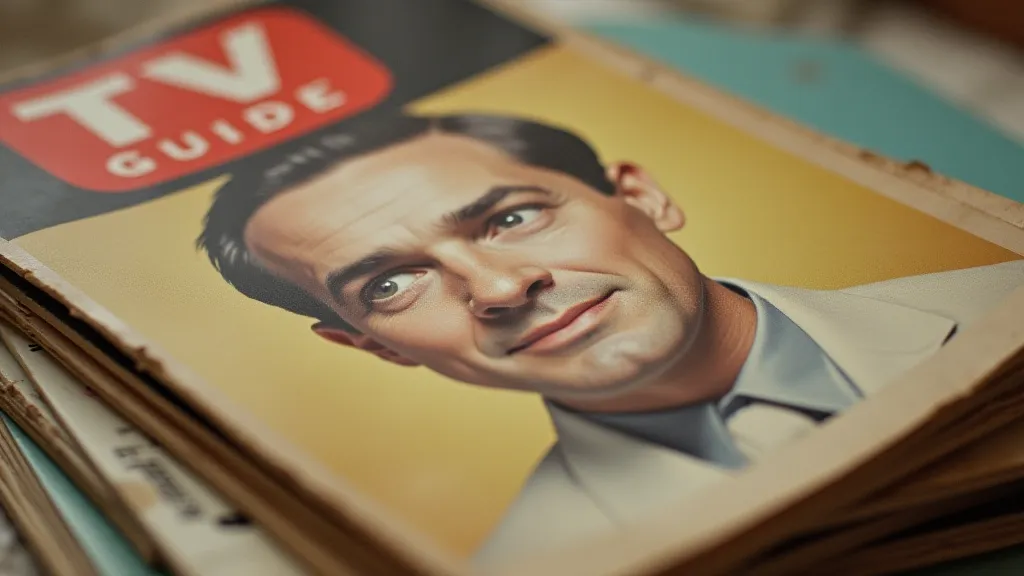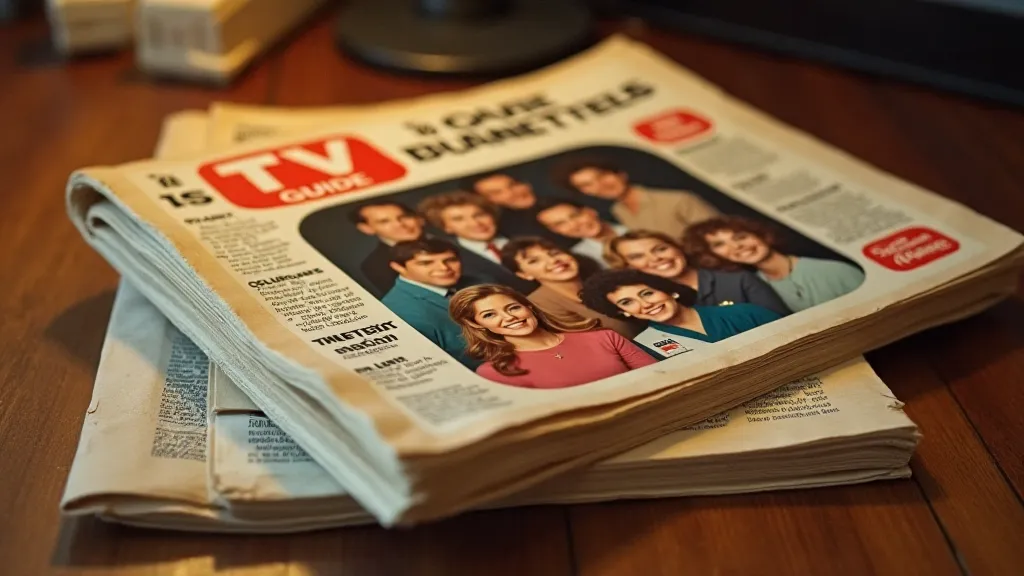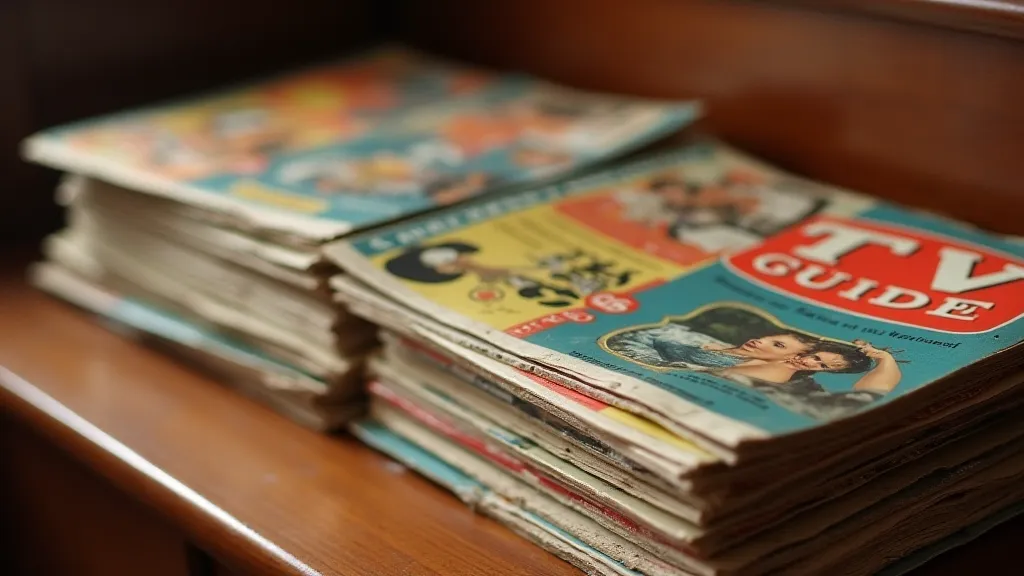The Cartographer of Dreams: How TV Guide Shaped National Viewing Habits
There's a certain fragrance that clings to aged paper – a comforting mix of vanilla, dust, and faded ink. For those of us who collect vintage TV Guide magazines, it’s the scent of a bygone era, a portal to evenings spent huddled around the flickering black and white glow of a television set. More than just a listing of programs, these magazines were, and are, cartographers of dreams, charting the landscape of American viewing habits and subtly, powerfully, shaping what families across the nation chose to watch.
My own fascination began with my grandfather. He was a quiet man, a craftsman in his own right, repairing clocks and radios – a tangible connection to the technology he loved. He had a stack of TV Guides from the 1960s, carefully preserved. Flipping through them, the glossy covers depicting smiling stars like Lucille Ball and Dick Van Dyke, I wasn’t just looking at television schedules; I was touching history. Each magazine felt like a tiny, perfectly preserved moment in time.

Regional Realities: The Power of Local Editions
Most people think of TV Guide as a national institution, and to a degree, it was. However, the true genius of the magazine lay in its regional editions. From the Midwest’s distinctive listings to the distinctly different schedules of the West Coast, these weren't just minor variations; they reflected the cultural nuances of different regions. Network programming was, of course, standardized, but local stations held considerable power. These local stations often carried different shows, aired programs at different times to accommodate regional preferences (evening news, for example, had drastically different airing times in the east vs. the west), and carried local commercials that shaped consumer behavior. The TV Guides faithfully chronicled this landscape, making them invaluable for understanding the granular realities of American television consumption.
Consider the differences. In the 1950s, the early years of television, advertising revenue was heavily reliant on the novelty of the medium. Stations often experimented with different program formats and scheduling, leading to a fragmentation of viewing habits. The TV Guides reflected this, meticulously detailing these variations. A family in Des Moines, Iowa, might have seen different programming than a family in Miami, Florida, despite ostensibly watching the same network. The magazine acted as a translator, a guide through this sometimes-confusing world. Interestingly, the visual identity of TV Guide itself wasn’t static, evolving through various typographic choices over the decades; exploring “the typographer's legacy” reveals just how much the magazine's branding shifted alongside changing aesthetics.
The Craftsmanship of Connection: More Than Just a Listing
It’s easy to dismiss vintage TV Guides as simple program listings. But that’s to miss the point entirely. The magazines were meticulously crafted. The layout, the typography, the cover photography – everything was carefully considered. The art direction evolved over the decades, reflecting changing aesthetics and consumer preferences. Early issues, particularly those from the 1950s, often featured more detailed reviews and feature articles, reflecting a belief that television was a new art form worthy of critical examination. These early guides had an almost reverential tone, highlighting the talent involved in television production. Even the paper stock, a slightly heavier, more substantial feel compared to modern magazines, contributes to the feeling of quality and longevity.
Restoration of these magazines is a delicate process. The paper is fragile and prone to brittleness. Attempting to clean them often damages them further. Careful storage in acid-free sleeves is crucial for preservation. The real beauty lies in the imperfections – the slightly faded cover, the dog-eared page, the faint coffee stain – these are the fingerprints of history, proof that the magazine was loved and cherished by someone else. The subtle discoloration isn’t a flaw, it’s a testament to the passage of time, a tangible link to the past. Beyond the core listings, the advertisements contained within these magazines offer a vibrant snapshot of a bygone era. Examining “a catalog of moments” reveals how these fleeting appearances in TV Guide ads captured the zeitgeist of the time.
The 1960s: A Decade of Transformation
The 1960s witnessed a profound transformation in American television and in the role of the TV Guide. The rise of color broadcasting brought a new visual dynamism to the medium. The assassination of John F. Kennedy, the Vietnam War, the Civil Rights Movement – these events unfolded on television screens, shaping national consciousness. The magazine reflected these seismic shifts, attempting to grapple with the complexities of a rapidly changing world. The format began to shift, with less focus on detailed reviews and more on celebrity profiles and behind-the-scenes glimpses into the television industry. The magazine became a cultural barometer, a reflection of the anxieties and aspirations of the American people.

Beyond the Listings: A Social Document
For collectors like myself, vintage TV Guides are more than just program listings; they’re social documents. They offer a unique window into the past, revealing not only what people were watching but also how they were living. The advertisements provide a fascinating glimpse into consumer culture, showcasing the products and services that were popular at the time. The editorial content reflects the social and political issues that were shaping the nation. These magazines offer a rich tapestry of information that goes far beyond the simple act of television viewing.
Identifying TV Guide rarity can be surprisingly complex. First-edition covers, particularly those featuring popular shows or celebrities, are highly sought after. Regional variations, especially those from areas with short-lived television stations, can also command a premium. Condition is, of course, a major factor. Magazines in pristine condition are rare and valuable. The 1950s magazines are generally considered more valuable, as fewer copies have survived the test of time. Understanding TV Guide subscription history can also help ascertain value. Limited-run promotional editions, for example, are exceptionally collectible. The methods employed to authenticate these valuable pieces are evolving, mirroring the meticulousness with which collectors approach their hobby. For a deeper dive into the nuances of verification, check out “a collector’s codex” for authentication tips.
The connection I feel to these old magazines is deeply personal. They remind me of my grandfather, of evenings spent watching television with my family, of a simpler time. Holding a vintage TV Guide in my hands is like holding a piece of my childhood. They represent a tangible link to the past, a reminder of the power of television to shape our culture and our memories. They are, in essence, cartographers of dreams, charting the landscape of American viewing habits for generations to come. The evolution of comedy itself is reflected in these pages, from the early sitcoms to the groundbreaking shows that redefined the genre. Exploring “echoes of laughter” unveils how vintage TV Guides illustrate this dynamic shift.

Beyond simply documenting schedules, the magazine also played a vital role in shaping the perception of television as a medium. The editorial choices – the stories covered, the talent highlighted – contributed to a broader cultural conversation about the art and impact of television. This influence extended to the very design of the television sets themselves, as manufacturers sought to create products that complemented the viewing experience promised by publications like TV Guide.
The sheer volume of information contained within each issue is staggering when considered in the context of the technological limitations of the time. No internet, no digital archives – just paper, ink, and the dedication of countless individuals working to bring families across the nation a glimpse into the world of television. This meticulous process, from the initial concept to the final printed edition, is a testament to the enduring legacy of TV Guide.
Furthermore, the magazine's success paved the way for other media publications focused on entertainment and pop culture. Its formula – a blend of practical information, insightful commentary, and aspirational imagery – became a template for countless magazines and websites that continue to thrive today. The influence of TV Guide extends far beyond the world of television itself, shaping the way we consume and interact with media in the digital age.
The enduring appeal of vintage TV Guide magazines lies not only in their historical significance but also in their ability to evoke a sense of nostalgia and connection to a simpler time. They are tangible reminders of a shared cultural experience, a testament to the power of television to unite families and shape our collective memory.





